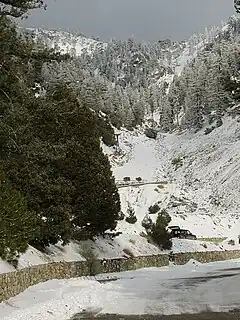| Mt Baldy Ski Lifts | |
|---|---|
 January 2007 | |
 Mt. Baldy Location in the United States  Mt. Baldy Location in California | |
| Location | Mount San Antonio and Telegraph Peak, California, U.S. |
| Nearest major city | Mt. Baldy, Los Angeles - 45 mi (72 km) |
| Coordinates | 34°16′N 117°37′W / 34.27°N 117.62°W |
| Vertical | 2,100 ft (640 m) |
| Top elevation | 8,600 ft (2,620 m) |
| Base elevation | 6,500 ft (1,980 m) |
| Skiable area | 800 acres (3.2 km2) |
| Runs | 26 total |
| Longest run | 2.5 miles (4.0 km) |
| Lift system | 4 chairlifts |
| Snowfall | 170 in (14 ft; 430 cm) |
| Snowmaking | Yes |
| Night skiing | None |
| Website | mtbaldyresort.com |
The Mount Baldy Ski Lifts, or "Baldy", is a ski resort in the western United States in southern California. Forty-five miles (72 km) east-northeast of Los Angeles in San Bernardino County, it is located on Mount San Antonio—Mount Baldy in the San Gabriel Mountains.
History
The vintage ski lifts were installed in 1952 by Harwood Developments. They were operated as Mt Baldy Ski Lifts Inc. and were managed by Herbert Leffler from 1953 until his retirement in 1969. The resort was sold to an investment group in 1969.
In 1987, Bob Olson proposed a project to make Baldy "The Disneyland of the Mountains."[1]
Facilities

The ski resort features traditional runs, open bowls, chutes, and tree runs; and claims to be the "largest and steepest resort in Southern California," with 26 runs and four chair lifts spanning 3 mountains featuring a peak elevation of 8,600 ft (2,620 m). Baldy spans 800 acres (3.2 km2) designated for skiing with a 2,100-foot (640 m) vertical drop.
The ski area is multi-directional, with portions of the main ski area facing south or southwest and other portions north-facing. Thunder Mountain areas serviced by Chair 3 are north-facing, resulting in longer-lasting snow conditions. The majority of the steep Chair 1 terrain down to the base area and parking lot along with the Chair 4 portion of the resort faces west and south, resulting in frequent spring conditions and corn snow. Snow on the lower portion of the mountain is typically hard with afternoon softening on north-facing slopes due to brief thaw/shade conditions. In times of abundant snowfall, prior to the complete solar melting of the snowpack on south-facing slopes, there is sunny skiing on the slopes from Chair 4 down to the base area.
The annual snowfall of Mt. Baldy is highly variable, due to southern California mountain weather patterns. In some seasons there is insufficient natural snow to operate the ski area for more than a few days (if at all). In other seasons, particularly certain El Niño years, several feet of snow can accumulate and provide for good daily operation of the ski area and widespread off-piste skiing.[2]
Lifts
Chairs #1 and #3 were built in 1952 by Ringer Chairlifts and featured double swiveling chairs which allowed riders to stand up when unloading.[3] When unloading riders just had to stand up in the landing area and the swiveling chairs would automatically move out of the way and pass the rider. The double swiveling chairs had some design flaws. The chair design did not take in account riders' natural instinct to move away from the unloading area quickly. Ringer Chairlifts went out of business just two years later.
In 1975 Swiss company GMD Mueller was contracted to upgrade the existing lifts reusing the old towers and to build chairs #2 and #4.
Gallery
 Chair #4 at Mt. Baldy
Chair #4 at Mt. Baldy Skiing overlooking Los Angeles
Skiing overlooking Los Angeles Skiing at Mt. Baldy
Skiing at Mt. Baldy Skiers at Mt. Baldy
Skiers at Mt. Baldy The base of Chair #2 at Mt. Baldy with Thunder Mountain in the background
The base of Chair #2 at Mt. Baldy with Thunder Mountain in the background
References
- ↑ Ryon, Ruth (11 January 1987). "'Disneyland of the Mountains' : Mt. Baldy Resort Operator Sought". Los Angeles Times. Retrieved 9 March 2023.
- ↑ "Analysis of Southern California Snow Conditions". BestSnow. 2004. Archived from the original on 19 January 2007. Retrieved 16 January 2011.
- ↑ "Ringer Chairlifts". Skilifts. 2004. Archived from the original on 3 July 2009. Retrieved 16 January 2011.